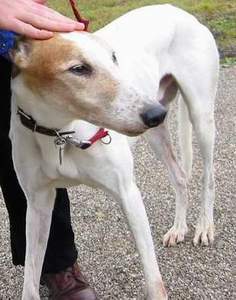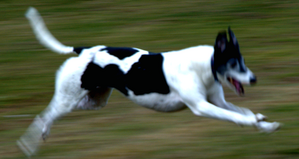Greyhound
Dogs
Greyhound
| Greyhound |

Greyhound
|
| Alternative names |
| English Greyhound |
| Country of origin |
| uncertain; possibly
England or
Egypt |
| Common nicknames |
| |
| Classification and breed standards |
|
FCI: |
Group 10 Section 3 #158 |
|
|
AKC: |
Hound |
|
|
ANKC: |
Group 4 (Hounds) |
|
|
CKC: |
Group 2 - Hounds |
|
|
KC (UK): |
Hound |
|
|
NZKC: |
Hounds |
|
|
UKC: |
Sighthounds and Pariah Dogs |
|
| Not recognized by any major kennel club |
| This breed of dog is
extinct |
| Notes |
| |
The Greyhound is a
breed of
dog used for hunting
and racing. They are one of the fastest land mammals; their combination of long,
powerful legs, deep chests and aerodynamic build allows them to reach speeds of
up to 72 km/h (45
mph).
Appearance
 Greyhound pup
Greyhound pup
Male dogs are usually 71 to 76
cm
(28 to 30 inches)
tall at the
withers and weigh around 29 to 36
kg (65 to
90
pounds). Females tend to be smaller with shoulder heights ranging from 68 to
71 cm (27 to 28 inches) and weights from 27 to 31 kg (50 to 75 pounds).
Greyhounds have very short hair, which is easy to maintain. There are
approximately thirty recognized color forms, of which variations of white,
brindle, fawn, black, red, blue, and grey can appear uniquely or in combination.
Temperament
Although greyhounds are extremely fast dogs, they are not high-energy dogs.
They are sprinters, and although they love running, do not require extensive
exercise once they leave the track. Most are quiet, gentle animals. Greyhounds
are often referred to as "Forty-five mile an hour
couch
potatoes."
Greyhounds can make good pets because of their mild and affectionate
character. They can get along well with children and family pets (often
including cats). Greyhounds are generally loyal, tractable dogs with developed
intellects, although their territorial instinct is weak and they make poor
guard dogs.
Their talents include sighting and hunting. They do not have undercoats and
therefore are less likely to trigger people's dog allergies (greyhounds are
sometimes incorrectly referred to as "hypoallergenic").
Most greyhounds that live as pets are adopted after they retire from racing.
Most companion greyhounds are kept on a leash because their hunting
background has instilled a strong desire to chase things. Greyhounds can live in
an urban setting but require moderate exercise on a regular basis. They enjoy
walking and running outside.
An adult greyhound will stay healthy and happy with a daily walk of as little
as 20 to 30 minutes. However, as greyhounds have a body fat of around 16%,
compared to an average of 25% in other canines, overdoing their exercise can be
detrimental to their health.
 Greyhound in flight
Greyhound in flight
History
Popularly, the breed's origin is believed to be traced to ancient
Egypt, where a
bas-relief
depicting a smooth-coated
Saluki (Persian
Greyhound) or
Sloughi was found in a
tomb built in
4000 BC.
Analyses of DNA
reported in 2004,
however, suggest that the greyhound is not closely related to these breeds, but
is a close relative to
herding
dogs.
[1]
[2]
Historically, these
sight
hounds have been used primarily for hunting in the open where their keen
eyesight is
a distinct advantage. It is believed that they (or at least similarly-named
dogs) were introduced to
England in
the 5th and 6th centuries BC by the
Celts during their
invasions.
The name "greyhound" is generally believed to come from the Old English
grighund. "Hund" is traced to the modern "hound", but the meaning of "grig"
is undetermined, other than in reference to dogs in Old English and Norse. Its
origin does not appear to have any common root with the modern word "grey"
for colour, and indeed the greyhound is seen with a wide variety of coats.
According to Pokorny's Indogermanisches Woerterbuch (p. 441-442) the English
name "greyhound" does not mean "a gray dog/hound", but simply "a fair dog".
Subsequent words have been derived from the indoeuropean root *g'her- 'shine,
twinkle': Eng. "gray", Old High German "gris" 'grey, old', Old Icelandic "griss"
'piglet, pig', Old Icld. "gryja" 'to dawn', "gryjandi" 'morning twilight', Old
Irish "grian" 'sun', Old Church Slavonic "zorja" 'morning twilight, brightness'.
The common sense of these words is 'to shine; bright'.
Until the early twentieth century, greyhounds were principally bred and
trained for
coursing. During the early
1920s, modern
greyhound racing was introduced into the United States and introduced into
United Kingdom and Ireland in
1926.
See main article at
Greyhound racing
Welfare
 Photo finish of a Greyhound race in
Tampa,
Florida,
USA on
February 9,
1939
Photo finish of a Greyhound race in
Tampa,
Florida,
USA on
February 9,
1939
In the late
20th
century several
Greyhound adoption groups were formed. The early groups were formed in large
part out of a sense of concern about the treatment of the dogs while living on
the track. These groups began taking greyhounds from the racetracks when they
could no longer compete and placing them in adoptive homes. Previously, in the
United States over 20,000 retired greyhounds a year were killed; recent
estimates still number in the thousands, with about 90% of National Greyhound
Association-registered animals either being adopted, or returned for breeding
purposes (according to the industry numbers upwards of 2000 dogs are still
killed annually)[3].
Accidents and disease are also common killers among racing greyhounds. In
2005, an
epidemic of
respiratory failure killed dozens of dogs and left over 1200
quarantined
in the U.S., particularly in
Massachusetts,
Colorado,
Iowa and
Rhode
Island.
The vast majority of greyhounds are bred for racing, leading registered
American Kennel Club dogs about 150:1, and as such each dog is issued a
Bertillon card, which measures 56 distinct identifying traits, and the
Bertillon number is
tattooed on the dog's ear, so as to ensure that the dog who races is in fact
the dog it is claimed to be. However, not all
National Greyhound Association registered dogs race. There are several
reasons why some greyhounds never race:
- The dog is too slow.
- The dog has physical defects.
- The dog does not have the required temperament.
- The dog is not raised in a country where racing is popular.
- The dog is bred for showing instead of racing.
Most greyhounds finish racing between two and five years of age. Some retired
racing greyhounds have injuries that may follow them for the remainder of their
lives.
Veterinary Care
Due to the unique
physiology
and anatomy
of greyhounds, a
veterinarian who understands the issues relevant to the breed is generally
needed when the dogs need treatment, particularly when
anaesthesia is required. Greyhounds demonstrate unusual blood chemistry,
which can be misread by veterinarians not familiar with the breed; this can
result in an incorrect diagnosis. Greyhounds have much less fat than other dogs,
and therefore can not metabolize anesthesia as quickly. A female may have an
elevated risk of cancer if she was administered hormones during her racing
career. Greyhounds have higher levels of red blood cells than do other breeds.
As red blood cells carry oxygen to the lungs, this characteristic help the
breed's speed. Veterinary blood services often use greyhounds as universal blood
donors.
Miscellaneous
In the media
- Simpson's Santa's Little Helper
- The most widely recognized greyhound in popular culture is the fictional
character
Santa's Little Helper from the
Fox Broadcasting Company's animated series,
The
Simpsons.
- The character Santa's Little Helper exhibits many of the intellectual
and behavioural characteristics of the typical greyhound as a pet. He is
portrayed as affectionate, tolerant of other household pets (notably cats),
loyal, and not overly active. His origins on the program stem from an
episode in which
Homer Simpson, after placing a losing bet on Santa's Little Helper in a
greyhound race, discovers that because of his poor performance, his owner
has discarded him to the streets to fend for himself.
- In keeping with the perception that The Simpson family comprises
"losers" and "outcasts", Homer decides that Santa's Little Helper is too
much like the rest of the family to not be a perfect addition.
- Santa's Little Helper has been a supporting character ever since, though
he once nearly died due to a twisted bowel. Unlike real greyhounds, however,
Santa's Little Helper is known to sit. Due to the peculiarities of greyhound
anatomy, greyhounds never really "sit." Although they may assume the
posture, they never put their full weight on their rear, instead putting it
in muscle tension.
- The
Greyhound Lines bus company
- In keeping with their logo, which sports a racing greyhound, Greyhound
occasionally airs television commercials starring a talking
computer-generated greyhound. The greyhound in these commercial shorts is
often noted for his dry, deadpan wit.
Anatomy
An additional peculiarity of greyhounds is that they have a hinged spine,
which is unique in the animal world. As a result, greyhounds have a small
"divot" in their back, set just behind their shoulder blades.
The racing gait of the greyhound is a double suspension gallop, in which all
four feet are off the ground twice during each full stride.
Sports
- The Greyhound is the mascot of the
Assumption College sports teams.
- The OHL
hockey team in
Sault Ste. Marie, Ontario,
Canada is
called the
Greyhounds.
- There is an indoor football team based in West Virginia called the Ohio
Valley Greyhounds.
See also
References
- Note 1: Mark Derr
(May 21, 2004). "Collie or Pug? Study Finds the Genetic Code".
The New York Times.
[4]
- Note 2: Parker
et al (May 21, 2004). "Genetic Structure of the Purebred Domestic Dog".
Science volume 304, pp. 1160-1164.
- Note 3: From
Greyhound Racing Accociation Please Note: this figure does not
include information about unregistered litters, nor outcomes for dogs after
they finished as breeding dogs. All figures are disputed by some adoption
groups.
Home | Up | Galgo Español | German Shepherd Dog | German Shorthaired Pointer | German Spitz | German Wirehaired Pointer | Giant Schnauzer | Glen of Imaal Terrier | Golden Retriever | Goldendoodle | Gordon Setter | Grand Basset Griffon Vendeen | Grand Bleu de Gascogne | Grand Griffon Vendéen | Great Dane | Greater Swiss Mountain Dog | Greenland_Dog | Greyhound | Griffon Bruxellois
Dogs, made by MultiMedia | Free content and software
This guide is licensed under the GNU
Free Documentation License. It uses material from the Wikipedia.
|




